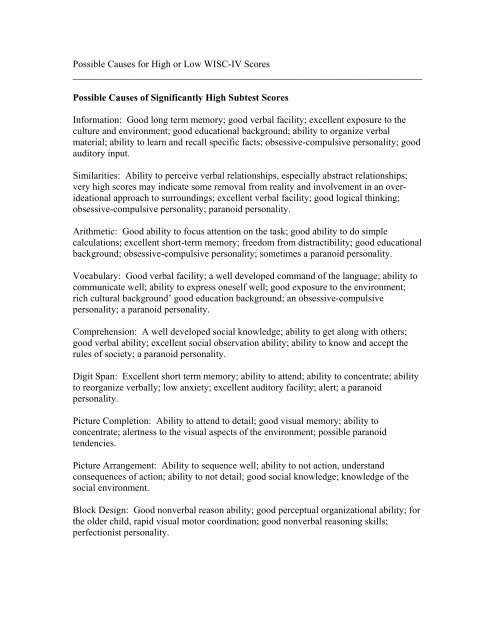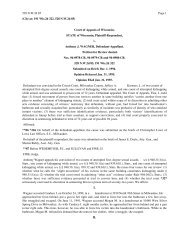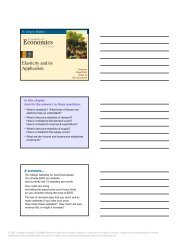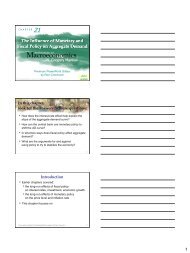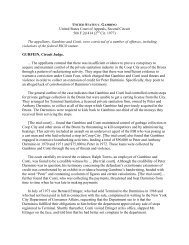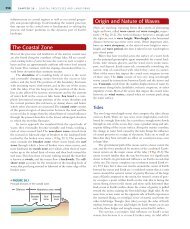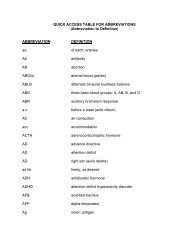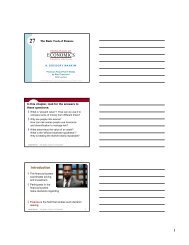Possible Causes for High or Low WISC-IV Scores - Cengage Learning
Possible Causes for High or Low WISC-IV Scores - Cengage Learning
Possible Causes for High or Low WISC-IV Scores - Cengage Learning
Create successful ePaper yourself
Turn your PDF publications into a flip-book with our unique Google optimized e-Paper software.
<strong>Possible</strong> <strong>Causes</strong> <strong>f<strong>or</strong></strong> <strong>High</strong> <strong>or</strong> <strong>Low</strong> <strong>WISC</strong>-<strong>IV</strong> Sc<strong>or</strong>es<br />
________________________________________________________________________<br />
<strong>Possible</strong> <strong>Causes</strong> of Significantly <strong>High</strong> Subtest Sc<strong>or</strong>es<br />
In<strong>f<strong>or</strong></strong>mation: Good long term mem<strong>or</strong>y; good verbal facility; excellent exposure to the<br />
culture and environment; good educational background; ability to <strong>or</strong>ganize verbal<br />
material; ability to learn and recall specific facts; obsessive-compulsive personality; good<br />
audit<strong>or</strong>y input.<br />
Similarities: Ability to perceive verbal relationships, especially abstract relationships;<br />
very high sc<strong>or</strong>es may indicate some removal from reality and involvement in an overideational<br />
approach to surroundings; excellent verbal facility; good logical thinking;<br />
obsessive-compulsive personality; paranoid personality.<br />
Arithmetic: Good ability to focus attention on the task; good ability to do simple<br />
calculations; excellent sh<strong>or</strong>t-term mem<strong>or</strong>y; freedom from distractibility; good educational<br />
background; obsessive-compulsive personality; sometimes a paranoid personality.<br />
Vocabulary: Good verbal facility; a well developed command of the language; ability to<br />
communicate well; ability to express oneself well; good exposure to the environment;<br />
rich cultural background’ good education background; an obsessive-compulsive<br />
personality; a paranoid personality.<br />
Comprehension: A well developed social knowledge; ability to get along with others;<br />
good verbal ability; excellent social observation ability; ability to know and accept the<br />
rules of society; a paranoid personality.<br />
Digit Span: Excellent sh<strong>or</strong>t term mem<strong>or</strong>y; ability to attend; ability to concentrate; ability<br />
to re<strong>or</strong>ganize verbally; low anxiety; excellent audit<strong>or</strong>y facility; alert; a paranoid<br />
personality.<br />
Picture Completion: Ability to attend to detail; good visual mem<strong>or</strong>y; ability to<br />
concentrate; alertness to the visual aspects of the environment; possible paranoid<br />
tendencies.<br />
Picture Arrangement: Ability to sequence well; ability to not action, understand<br />
consequences of action; ability to not detail; good social knowledge; knowledge of the<br />
social environment.<br />
Block Design: Good nonverbal reason ability; good perceptual <strong>or</strong>ganizational ability; <strong>f<strong>or</strong></strong><br />
the older child, rapid visual mot<strong>or</strong> co<strong>or</strong>dination; good nonverbal reasoning skills;<br />
perfectionist personality.
Object Assembly: Good visual-mot<strong>or</strong> co<strong>or</strong>dination; good holistic, visual integrative style<br />
of reasoning; good visual mem<strong>or</strong>y; rapid construction of the items; a perfectionist;<br />
sometimes the ingratiating con man.<br />
Coding: Good non-verbal mem<strong>or</strong>y; ability to learn non-verbal material; rapid eye-hand<br />
co<strong>or</strong>dination; good perceptual skills; ability to sequence; good pencil facility; a<br />
perfectionist personality.<br />
Mazes: Ability to plan ahead; good perceptual skills; good visual-mot<strong>or</strong> ability; good<br />
eye-hand co<strong>or</strong>dination; a perfectionist personality.<br />
<strong>Possible</strong> <strong>Causes</strong> of Significantly <strong>Low</strong> Subtest Sc<strong>or</strong>es<br />
In<strong>f<strong>or</strong></strong>mation: Po<strong>or</strong> mem<strong>or</strong>y; low socio-economic conditions; po<strong>or</strong> cultural background;<br />
limited educational background; impoverished verbal facility; speech defect; verbal<br />
output dis<strong>or</strong>der; po<strong>or</strong> reality testing; repression; audit<strong>or</strong>y input problem.<br />
Similarities: Po<strong>or</strong> reasoning ability; weak abstract reasoning and thinking skills; po<strong>or</strong><br />
logical thinking skills; po<strong>or</strong> verbal facility; concrete thinking skills; inability to deal with<br />
ideas on a symbolic level; speech defect; po<strong>or</strong> reality testing; delinquency; verbal output<br />
dis<strong>or</strong>der; audit<strong>or</strong>y input problem.<br />
Arithmetic: Po<strong>or</strong> calculation skills; po<strong>or</strong> sh<strong>or</strong>t-term verbal mem<strong>or</strong>y; inattention;<br />
distractibility; po<strong>or</strong> concentration; low facility with numbers; inability to deal with the<br />
concrete; anxiety; po<strong>or</strong> reality testing; verbal output problem.<br />
Vocabulary: Po<strong>or</strong> verbal facility; limited educational background; social retreat and/<strong>or</strong><br />
withdrawal; speech defect; audit<strong>or</strong>y dis<strong>or</strong>der; non-standard cultural background;<br />
delinquency; po<strong>or</strong> reality testing; audit<strong>or</strong>y input problem; verbal output dis<strong>or</strong>der; nonstandard<br />
English usage.<br />
Comprehension: <strong>Low</strong> social intelligence; low social understanding; socially isolated;<br />
po<strong>or</strong> verbal skills; speech defect; inability to plan; delinquency; po<strong>or</strong> common sense;<br />
po<strong>or</strong> reality testing; audit<strong>or</strong>y input problem; verbal output dis<strong>or</strong>der.<br />
Digit Span: Po<strong>or</strong> sh<strong>or</strong>t-tem verbal mem<strong>or</strong>y; po<strong>or</strong> re<strong>or</strong>ganizing ability; inattention;<br />
distractibility; po<strong>or</strong> concentration; anxiety; audit<strong>or</strong>y deficit; inability to sequence;<br />
anxiety; thought process difficulty; sequential mem<strong>or</strong>y dis<strong>or</strong>der; verbal output dis<strong>or</strong>der.<br />
Picture Completion: Incapability to attend and concentrate; inability to note detail;<br />
anxiety; repression; po<strong>or</strong> visual mem<strong>or</strong>y; inability to not detail; inadequacy to not aspects<br />
of the environment; po<strong>or</strong> reality testing; depression; visual input dis<strong>or</strong>der; visual figureground<br />
dis<strong>or</strong>der.
Picture Arrangement: Inability to sequence; po<strong>or</strong> social knowledge; inadequacy to note<br />
action and plan of action’ lack of social skills; withdrawal; possible po<strong>or</strong> empathy;<br />
impulsive; inability to note detail; incapacity to respond to time pressure; anxiety;<br />
depression; po<strong>or</strong> reality testing; po<strong>or</strong> visual-mot<strong>or</strong> co<strong>or</strong>dination; visual input problem.<br />
Block Design: Po<strong>or</strong> perceptual skills; po<strong>or</strong> visual mot<strong>or</strong> co<strong>or</strong>dination; inability to deal<br />
with abstract; deficient non-verbal reasoning; visual problems; inattention; possible<br />
cerebral dysfunction; anxiety; depression; visual mot<strong>or</strong> co<strong>or</strong>dination; figure-ground<br />
dis<strong>or</strong>der; visual input dis<strong>or</strong>der.<br />
Object Assembly: Po<strong>or</strong> visual mem<strong>or</strong>y; po<strong>or</strong> visual-mot<strong>or</strong> co<strong>or</strong>dination; inattention;<br />
perceptual difficulties; inability to per<strong>f<strong>or</strong></strong>m under time pressure; possible cerebral<br />
dysfunction; anxiety; depression; po<strong>or</strong> reality testing; figure-ground dis<strong>or</strong>der; visual input<br />
dis<strong>or</strong>der.<br />
Coding: Po<strong>or</strong> non-verbal mem<strong>or</strong>y; po<strong>or</strong> visual-mot<strong>or</strong> co<strong>or</strong>dination; messy; inability to<br />
handle a pencil; inability to sequence; inattention; distractibility; low motivation; inability<br />
to operate under time pressure; visual input problem; possible cerebral dysfunction;<br />
anxiety; depression.<br />
Mazes: Po<strong>or</strong> visual mot<strong>or</strong> co<strong>or</strong>dination; impulsiveness; inability to handle a pencil;<br />
inability to plan ahead; po<strong>or</strong> visual ability; some possible cerebral dysfunction; anxiety;<br />
depression; visual input problem; visual figure-group dis<strong>or</strong>der.<br />
________________________________________________________________________<br />
Source: C.L. Nicholson & C.L. Alc<strong>or</strong>n, (April, 1993). Interpretation of the <strong>WISC</strong>-III and Its Subtests.<br />
Presentation at the Annual Meeting of the National Association of School Psychologists, Washington D.C.


